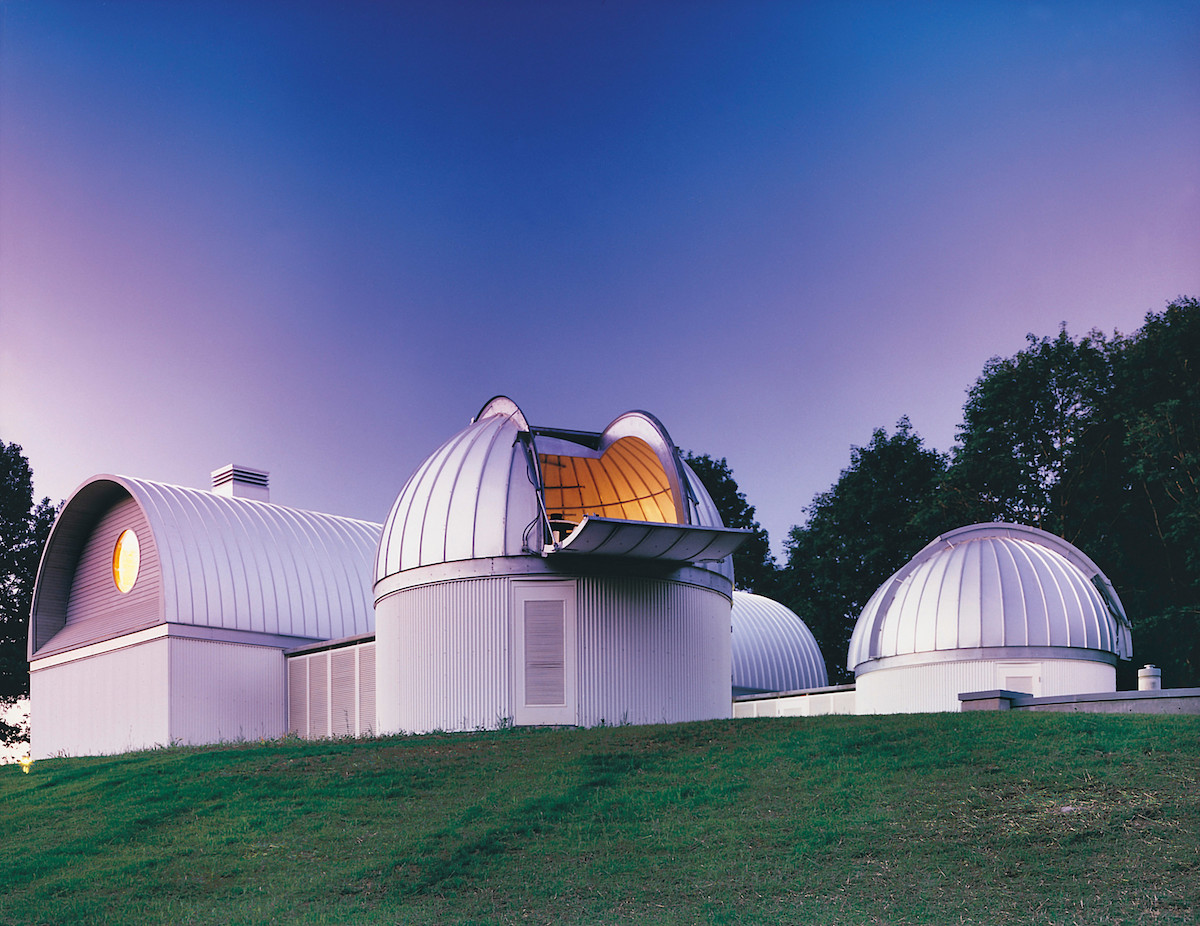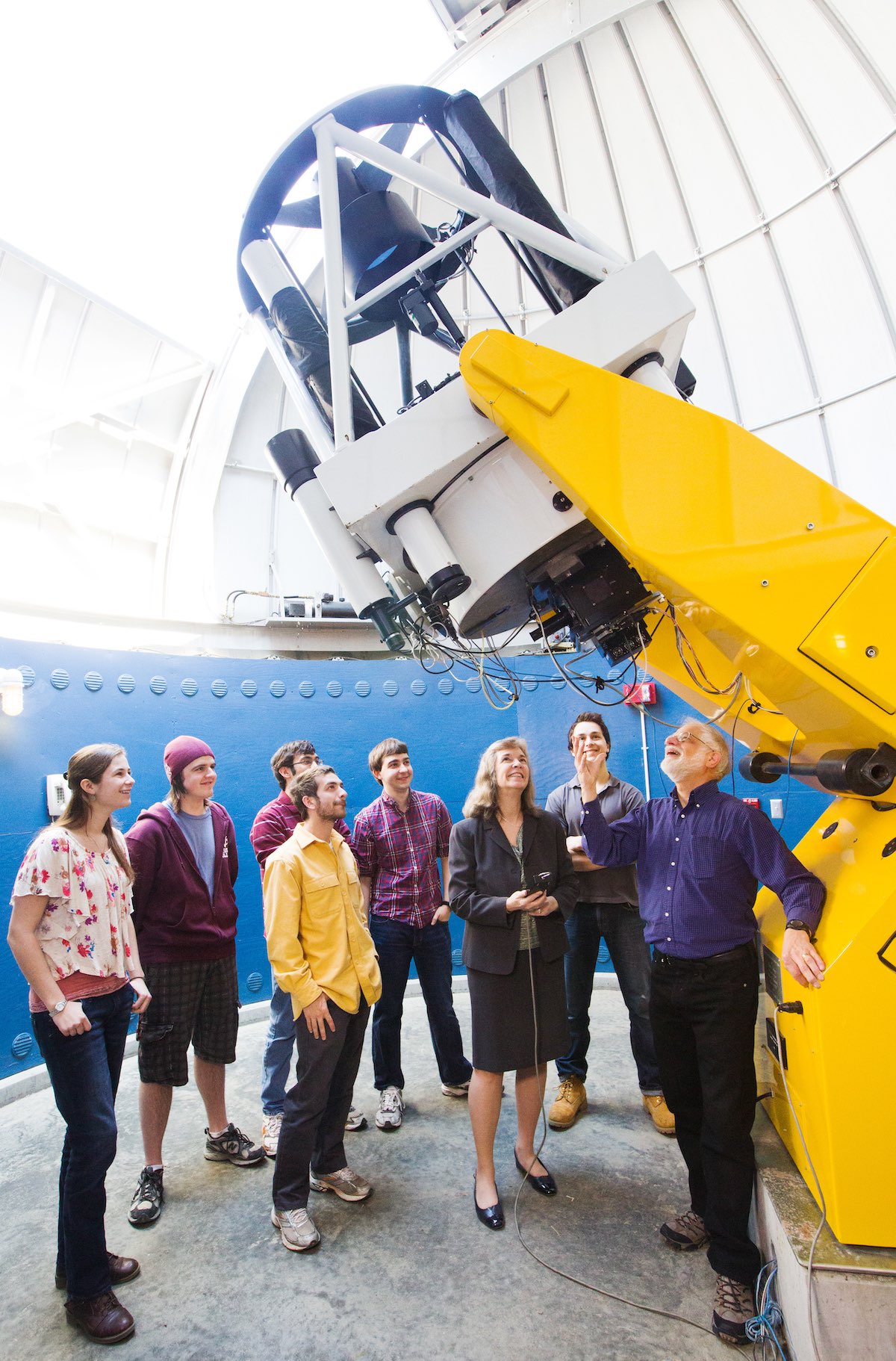The Class of 1951 Observatory

The Class of 1951 Observatory (1929)
William Tubby
Over the course of seven years, a fundraising event called the Campaign for Vassar raised $206,280,277. The largest fundraising campaign ever for a small liberal arts college, the solicitation was completed on June 30, 1996. Funds from the campaign would go to such projects as the Frances Lehman Loeb Art Center, a library expansion, and a new, state-of-the-art observatory, a two-domed structure overlooking Sunset Lake.
At the time, a national budget crisis was shutting down many scientific establishments. It was, however, the wish of the Vassar class of 1951 that a new observatory would “allow the next generation of students to probe the night skies,” a goal encouraged by Professor of Astronomy Henry Albers. A recent external review had suggested the addition of two new professors of astronomy at Vassar, and Albers had been responsible for the hiring of professors Fred Chromey and Debra Elmegreen. He had hoped originally to better improve the Maria Mitchell Observatory— built in 1864, dedicated in 1991to Vassar’s first astronomer and designated as a National Historic Landmark in 1992—with a larger and better telescope. However, as the old brick building retained heat and was surrounded by considerable campus light pollution, Albers and his colleagues came to the conclusion that the building was ill-suited for modern research, and undertook the campaign for a new observatory. Astronomers were sent to speak and conduct alumnae/i networking during the Campaign for Vassar. Dean of the Faculty Nancy Dye ’69 also lent support to the project, with her belief that the sciences at the time needed a boost. “In the early ’90s, science was the poor cousin on campus,” recalled Professor Elmegreen. Under the administration of President Frances Daly Fergusson, the project began to take form.
The class of 1951 raised the majority of the $2.1 million needed to construct and furnish the building. The first donation of $1 million came from Virginia Cretella Mars ’51, a Vassar trustee and the chair of the Campaign for Vassar, who called on her classmates to match her donation. Funding from the National Science Foundation granted the instrumentation, and the Mary K. Peabody Foundation and the John C. and Chara C. Haas Charitable Trust supplied the telescopes. A final design from New Haven architects Roth and Moore emerged in the spring of 1996, and the groundbreaking took place in the fall with Matthew Vassar’s shovel in hand, a long-standing tradition. The observatory opened in January 1997 to admiring reviews, with many a compliment paid to its futuristic architecture, which in 1998 won an award from the American Institute of Architects for “melding of a vernacular building with science” and its high-tech instruments. The Maria Mitchell Observatory became the site of the Education Department and the Office of the College Historian.

When it opened, the Class of 1951 Observatory housed the largest telescope in New York State, at 32 inches. It also included a second, 20-inch telescope assembled by the students of the Astronomy-240 class from some elements of a 15-inch telescope from the Maria Mitchell Observatory. Sensitive electronic cameras, known as CCDs, were attached to the telescopes so that images of stars and galaxies could be recorded directly to the observatory computers. A “warm room” contained computers and instruments for data communication with the rest of the college’s campus. A smaller dome contained the College’s 8-inch Alvan Clark refractor telescope (used by students in introductory and observational astronomy courses), an office, a classroom that doubled as a space for mechanical assembly, and an observation terrace. The first director of the new observatory was Professor of Astronomy Fred Chromey.
The research accessories planned for the observatory were numerous. Mirror doors aided in focusing light from distant stars. Computers manipulated the direction of the telescopes and the (often audibly squeaky) rotation of the domes. But even such an excellent, light-controlled observatory is limited in the research it can conduct in Poughkeepsie, where the skies are extraordinarily bright. Since visual and observational astronomy is hindered by the amount of light pollution, work on stars and galaxies has been historically superseded by work on, as Professor Elmegreen put it, “anything, be it in time or position.”
Under both Dr. Chromey and the succeeding director of the observatory, Professor Colette Salyk, the new observatory has become the focal point of research in Vassar’s physics and astronomy department. Also, in partnership with the Keck Northeast Astronomy Consortium, Vassar helped publish the most complete light curve of a 1998 supernova. “The advantage over a national observatory,” said Elmegreen, “is that we could look at this curve every night for a month, whereas astronomers in a larger observatory would have to reserve time.”
Also, in the observatory, Professor Salyk had her planetary science students look for protoplanetary disks and transits across stars, which could possibly indicate an exoplanet, or planets outside of our solar system. While most exoplanet candidates are discovered by satellites, the Class of 1951 Observatory has participated in a nationwide effort known as KELT-FUN, or the Kilodegree Extremely Little Telescope Follow-Up Network, where small observatories confirm potential exoplanet candidates discovered by satellites. Vassar students have confirmed several exoplanets over the years.
As well as for Vassar students, the observatory was envisioned, according to The Miscellany News, as an educational resource for the Poughkeepsie community. The 9-11 pm Wednesday night public observations date back to the observatory’s opening year, 1997. Each year ten or twelve laboratory technician students often lead tours at that time or host public observations during astronomical events such as meteor showers that draw hundreds of locals observers per year. The observatory is also available to private community groups, such Girl or Boy Scout troops. “There’s been a successful outreach effort,” Professor Elmegreen observed, “one that I think has helped two-college relations.”
The number of 250 students in Astronomy classes each year has not changed significantly after the observatory was built, disproving a presumption in the department that the observatory would bring in floods of astronomy majors. There are typically 20 physics or astronomy majors in each graduating class. Every astronomy student is either invited to observation nights or to participate, as a class requirement, in observational astronomy at the Class of 1951 observatory.
Sources
Interview with Professor Debra Elmegreen
“College sets record in fundraising campaign” The Miscellany News. 6 September 1996.
“Observatory nears completion” The Miscellany News. 13 September 1996.
“New observatory benefits majors and non-majors alike” The Miscellany News. 5 December 1997.
“Observatory wins award” The Miscellany News. 20 October 1998.
“Observatory offers amateur astronomers access to stars” The Miscellany News. 19 April 2012.
“Astronomers to take back the night” Vassar Quarterly. 1 September 1995.
LL, 2021